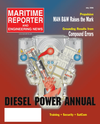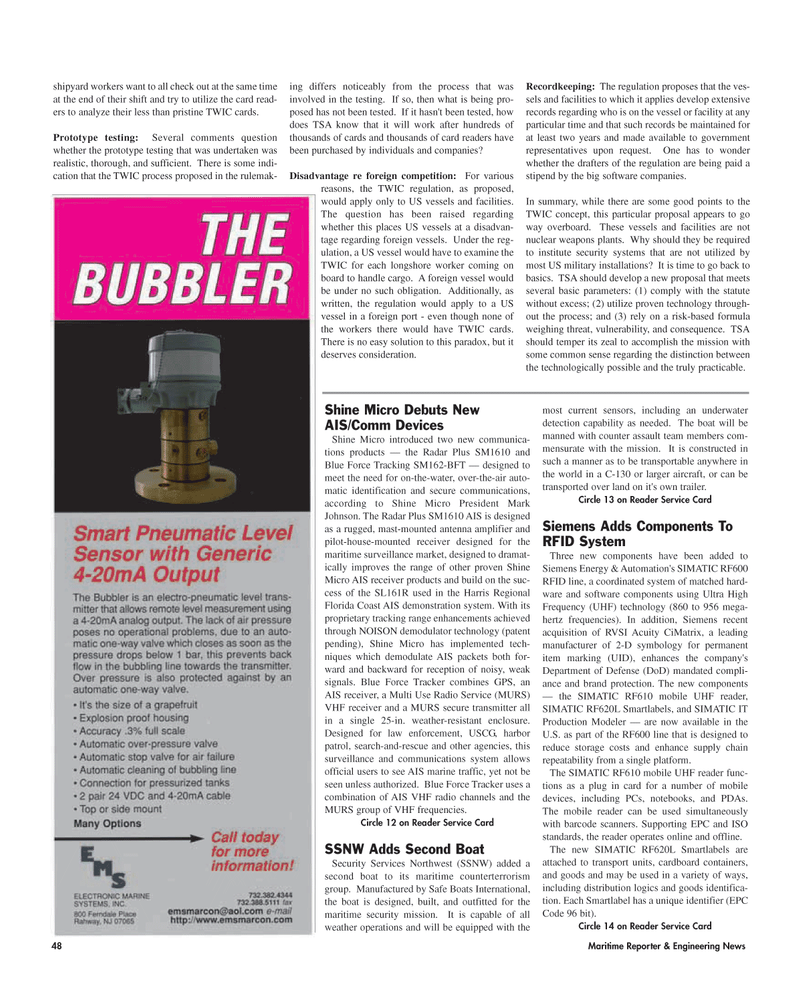
Page 48: of Maritime Reporter Magazine (July 2005)
The Satellite Communications Edition
Read this page in Pdf, Flash or Html5 edition of July 2005 Maritime Reporter Magazine
48 Maritime Reporter & Engineering News shipyard workers want to all check out at the same time at the end of their shift and try to utilize the card read- ers to analyze their less than pristine TWIC cards.
Prototype testing: Several comments question whether the prototype testing that was undertaken was realistic, thorough, and sufficient. There is some indi- cation that the TWIC process proposed in the rulemak- ing differs noticeably from the process that was involved in the testing. If so, then what is being pro- posed has not been tested. If it hasn't been tested, how does TSA know that it will work after hundreds of thousands of cards and thousands of card readers have been purchased by individuals and companies?
Disadvantage re foreign competition: For various reasons, the TWIC regulation, as proposed, would apply only to US vessels and facilities.
The question has been raised regarding whether this places US vessels at a disadvan- tage regarding foreign vessels. Under the reg- ulation, a US vessel would have to examine the
TWIC for each longshore worker coming on board to handle cargo. A foreign vessel would be under no such obligation. Additionally, as written, the regulation would apply to a US vessel in a foreign port - even though none of the workers there would have TWIC cards.
There is no easy solution to this paradox, but it deserves consideration.
Recordkeeping: The regulation proposes that the ves- sels and facilities to which it applies develop extensive records regarding who is on the vessel or facility at any particular time and that such records be maintained for at least two years and made available to government representatives upon request. One has to wonder whether the drafters of the regulation are being paid a stipend by the big software companies.
In summary, while there are some good points to the
TWIC concept, this particular proposal appears to go way overboard. These vessels and facilities are not nuclear weapons plants. Why should they be required to institute security systems that are not utilized by most US military installations? It is time to go back to basics. TSA should develop a new proposal that meets several basic parameters: (1) comply with the statute without excess; (2) utilize proven technology through- out the process; and (3) rely on a risk-based formula weighing threat, vulnerability, and consequence. TSA should temper its zeal to accomplish the mission with some common sense regarding the distinction between the technologically possible and the truly practicable.
Shine Micro Debuts New
AIS/Comm Devices
Shine Micro introduced two new communica- tions products — the Radar Plus SM1610 and
Blue Force Tracking SM162-BFT — designed to meet the need for on-the-water, over-the-air auto- matic identification and secure communications, according to Shine Micro President Mark
Johnson. The Radar Plus SM1610 AIS is designed as a rugged, mast-mounted antenna amplifier and pilot-house-mounted receiver designed for the maritime surveillance market, designed to dramat- ically improves the range of other proven Shine
Micro AIS receiver products and build on the suc- cess of the SL161R used in the Harris Regional
Florida Coast AIS demonstration system. With its proprietary tracking range enhancements achieved through NOISON demodulator technology (patent pending), Shine Micro has implemented tech- niques which demodulate AIS packets both for- ward and backward for reception of noisy, weak signals. Blue Force Tracker combines GPS, an
AIS receiver, a Multi Use Radio Service (MURS)
VHF receiver and a MURS secure transmitter all in a single 25-in. weather-resistant enclosure.
Designed for law enforcement, USCG, harbor patrol, search-and-rescue and other agencies, this surveillance and communications system allows official users to see AIS marine traffic, yet not be seen unless authorized. Blue Force Tracker uses a combination of AIS VHF radio channels and the
MURS group of VHF frequencies.
Circle 12 on Reader Service Card
SSNW Adds Second Boat
Security Services Northwest (SSNW) added a second boat to its maritime counterterrorism group. Manufactured by Safe Boats International, the boat is designed, built, and outfitted for the maritime security mission. It is capable of all weather operations and will be equipped with the most current sensors, including an underwater detection capability as needed. The boat will be manned with counter assault team members com- mensurate with the mission. It is constructed in such a manner as to be transportable anywhere in the world in a C-130 or larger aircraft, or can be transported over land on it's own trailer.
Circle 13 on Reader Service Card
Siemens Adds Components To
RFID System
Three new components have been added to
Siemens Energy & Automation's SIMATIC RF600
RFID line, a coordinated system of matched hard- ware and software components using Ultra High
Frequency (UHF) technology (860 to 956 mega- hertz frequencies). In addition, Siemens recent acquisition of RVSI Acuity CiMatrix, a leading manufacturer of 2-D symbology for permanent item marking (UID), enhances the company's
Department of Defense (DoD) mandated compli- ance and brand protection. The new components — the SIMATIC RF610 mobile UHF reader,
SIMATIC RF620L Smartlabels, and SIMATIC IT
Production Modeler — are now available in the
U.S. as part of the RF600 line that is designed to reduce storage costs and enhance supply chain repeatability from a single platform.
The SIMATIC RF610 mobile UHF reader func- tions as a plug in card for a number of mobile devices, including PCs, notebooks, and PDAs.
The mobile reader can be used simultaneously with barcode scanners. Supporting EPC and ISO standards, the reader operates online and offline.
The new SIMATIC RF620L Smartlabels are attached to transport units, cardboard containers, and goods and may be used in a variety of ways, including distribution logics and goods identifica- tion. Each Smartlabel has a unique identifier (EPC
Code 96 bit).
Circle 14 on Reader Service Card
MR JULY2006 #6 (41-48).qxd 7/5/2006 12:04 PM Page 48

 47
47

 49
49
